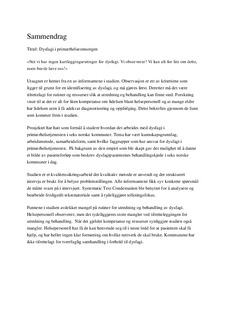| dc.contributor.advisor | Jaatun, Ellen Andreassen | |
| dc.contributor.advisor | Vaagan, Bjørn-Thore Hønstad | |
| dc.contributor.author | Kleivhaug, Rita Helen | |
| dc.date.accessioned | 2019-09-19T14:01:37Z | |
| dc.date.available | 2019-09-19T14:01:37Z | |
| dc.date.issued | 2019 | |
| dc.identifier.uri | http://hdl.handle.net/11250/2617794 | |
| dc.description.abstract | Tittel: Dysfagi i primærhelseomsorgen
«Nei vi har ingen kartleggingsrutinger for dysfagi. Vi observerer! Vi kan alt for lite om dette, noen burde lære oss!»
Utsagnet er hentet fra en av informantene i studien. Observasjon er ett av kriteriene som ligger til grunn for en identifisering av dysfagi, og må gjøres først. Deretter må det være tilrettelagt for rutiner og ressurser slik at utredning og behandling kan finne sted. Forskning viser til at det er alt for liten kompetanse om lidelsen blant helsepersonell og at mange eldre har lidelsen uten å få adekvat diagnostisering og oppfølging. Dette bekreftes gjennom de funn som kommer frem i studien.
Prosjektet har hatt som formål å studere hvordan det arbeides med dysfagi i primærhelsetjenesten i seks norske kommuner. Tema har vært kunnskapsgrunnlag, arbeidsmetode, samarbeidsform, samt hvilke faggrupper som har ansvar for dysfagi i primærhelsetjenesten. På bakgrunn av den empiri som ble skapt gav det mulighet til å danne et bilde av pasientforløp som beskrev dysfagipasientenes behandlingskjede i seks norske kommuner i dag.
Studien er et kvalitetssikringsarbeid der kvalitativ metode er anvendt og der strukturert intervju er brukt for å belyse problemstillingen. Alle informantene fikk syv konkrete spørsmål de måtte svare på i intervjuet. Systematic Text Condensation ble benyttet for å analysere og bearbeide ferdigstilt tekstmateriale samt å tydeliggjøre tolkningsfokus.
Funnene i studien avdekker mangel på rutiner for utredning og behandling av dysfagi. Helsepersonell observerer, men det tydeliggjøres store mangler ved tilretteleggingen for utredning og behandling. Når det gjelder kompetanse og ressurser synliggjør studien også mangler. Helsepersonell har få de kan henvende seg til i neste ledd for at pasienten skal få hjelp, og har heller ingen klar formening om hvilke nettverk de skal bruke. Kommunene har ikke tilrettelagt for tverrfaglig samhandling i forhold til dysfagi. | |
| dc.description.abstract | Title: Dysphagia in primary health care
"No we have no mapping routines for dysphagia. We observe! Our knowledge of this is too weak, someone should teach us!».
The statement is quoted from one of the informants in the study. Observation is one of the criteria underlying the identification of dysphagia, and must be done first. Thereafter, routines and resources must be adapted so that investigation and treatment can take place. Research indicates that there is a lack of expertise among health personnel about the suffering, and that many elderly people have the disorder without getting adequate diagnosis and follow-up. This is confirmed by the analysis and findings in the study.
The purpose of the project is to study how dysphagia is handled in primary health care in six Norwegian municipalities. Topics have been knowledge, working method, form of collaboration, and which disciplines are responsible for dysphagia in the primary health service. On the basis of the empirical data that was created, it gave the opportunity to figure out a patient care pathway that describes the treatment chain of dysphagia patients in Norwegian municipalities today.
The study is a quality assurance work, where the qualitative method and the structured interview are used to shed light on the issue. All the informants received seven specific questions they were asked to answer in the interview. Systematic Text Condensation was used to analyze and process refined text material and to clarify the focus of interpretation.
The findings of the study reveal a lack of routines for the examination and treatment of dysphagia. Health personnel observe, but there are clear deficiencies in the facilitation for examination and treatment. When it comes to expertise and resources, the study also highlights deficiencies. Health personnel have few to turn to in the next step, for the patient to get help, and also have no clear indication of which networks they should use. The municipalities have not facilitated interdisciplinary interaction in relation to dysphagia. | |
| dc.language | nob | |
| dc.publisher | NTNU | |
| dc.title | Dysfagi i orimærhelseomsorgen | |
| dc.type | Master thesis | |
